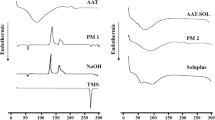Abstract
The roles of magnesium oxide (MgO) release from solid dispersions (SDs) in simulated gastric fluid (SGF), simulated intestinal fluid (SIF) and water were investigated to elucidate the enhanced dissolution and reduced intestinal damages of telmisartan as a model drug. The polyethylene glycol 6000 (PEG 6000) was used to prepare the SDs. Three SDs were prepared: SD1 (PEG, MgO, TEL), SD2 (PEG 6000, TEL), SD3 (MgO, TEL). The physical mixture (PM) consisting of SD2 and MgO was also prepared. A binary SD without MgO (SD2) was also prepared for comparison in microenvironmental pH (pHM) modulation. The faster MgO released, the less control of pHM and the less enhanced dissolution of TEL were in consequences. SD3 increased dissolution in SIF and water (about 67%). Interestingly, ternary SD1 showed almost complete dissolution in all three media but dissolution of PM was the lowest due to the fast release of MgO and poor modulation of pHM. MgO did not change the drug crystallinity but did have a strong molecular interaction with the drug. Additionally, the SD3-bearing tablet quickly increased pHM but then gradually decreased due to faster release of MgO while the SD1-bearing tablet gradually increased pHM at all fractional dimensions of the tablet by the MgO slowly released. The pHM of PM-bearing tablets was not varied as a function of time. Thus, the MgO-bearing SD1 also minimized gastrointestinal tissue damage caused by the model drug.
Similar content being viewed by others
References
Chiou, W. L. and Riegelman, S., Pharmaceutical applications of solid dispersion systems. J. Pharm. Sci., 60, 1281–1302 (1971).
Craig, D. Q., The mechanisms of drug release from solid dispersions in water-soluble polymers. Int. J. Pharm., 231, 131–144 (2002).
Ford, J. L., The current status of solid dispersions. Pharm. Acta Helv., 61, 69–88 (1986).
Heo, M. Y., Piao, Z. Z., Kim, T. W., Cao, Q. R., Kim, A., and Lee, B. -J., Effect of solubilizing and microemulsifying excipients in polyethylene glycol 6000 solid dispersion on enhanced dissolution and bioavailability of ketoconazole. Arch. Pharm. Res., 28, 604–611 (2005).
Kai, T., Akiyama, Y., Nomura, S., and Sato, M., Oral absorption improvement of poorly soluble drug using solid dispersion technique. Chem. Pharm. Bull., 44, 568–571 (1996).
Lengeling, R. W., Mitros, F. A., Brennan, J. A., and Schulze, K. S., Ulcerative ileitis encountered at ileo-colonoscopy: likely role of nonsteroidal agents. Clin. Gastroenterol. Hepatol., 1, 160–169 (2003).
Leuner, C. and Dressman, J., Improving drug solubility for oral delivery using solid dispersions. Eur. J. Pharm. Biopharm., 50, 47–60 (2000).
Pillay, V. and Fassihi, R., Electrolyte-induced compositional heterogeneity: a novel approach for rate-controlled oral drug delivery. J. Pharm. Sci., 88, 1140–1148 (1999).
Riis, T., Bauer-Brandl, A., Wagner, T., and Kranz, H., pHindependent drug release of an extremely poorly soluble weakly acidic drug from multiparticulate extended release formulations. Eur. J. Pharm. Biopharm., 65, 78–84 (2007).
Siepe, S., Lueckel, B., Kramer, A., Ries, A., and Gurny, R., Strategies for the design of hydrophilic matrix tablets with controlled microenvironmental pH. Int. J. Pharm., 316, 14–20 (2006).
Streubel, A., Siepmann, J., Dashevsky, A., and Bodmeier, R., pH-independent release of a weakly basic drug from water-insoluble and -soluble matrix tablets. J. Control. Release, 67, 101–110 (2000).
Tran, P. H. L., Tran, H. T. T., and Lee, B.-J., Modulation of microenvironmental pH and crystallinity of ionizable telmisartan using alkalizers in solid dispersions for controlled release. J. Control. Release, 129, 59–65 (2008).
Tran, T. T.-D., Tran, P. H.-L., and Lee, B.-J., Dissolutionmodulating mechanism of alkalizers and polymers in nanoemulsifying solid dispersion containing ionizable and poorly water-soluble drug. Eur. J. Pharm. Biopharm., 72, 83–90 (2009).
Author information
Authors and Affiliations
Corresponding author
Rights and permissions
About this article
Cite this article
Phuong, HL.T., Tran, T.TD., Lee, S.A. et al. Roles of MgO release from polyethylene glycol 6000-based solid dispersions on microenvironmental pH, enhanced dissolution and reduced gastrointestinal damage of telmisartan. Arch. Pharm. Res. 34, 747–755 (2011). https://doi.org/10.1007/s12272-011-0508-2
Received:
Revised:
Accepted:
Published:
Issue Date:
DOI: https://doi.org/10.1007/s12272-011-0508-2




